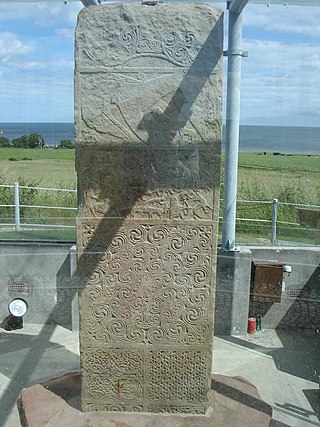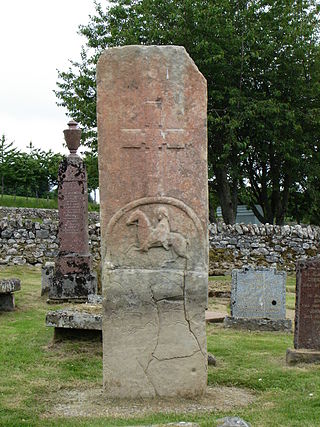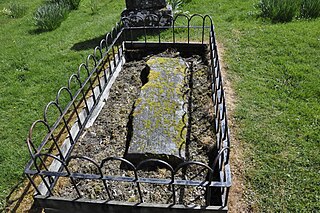
A Pictish stone is a type of monumental stele, generally carved or incised with symbols or designs. A few have ogham inscriptions. Located in Scotland, mostly north of the Clyde-Forth line and on the Eastern side of the country, these stones are the most visible remaining evidence of the Picts and are thought to date from the 6th to 9th century, a period during which the Picts became Christianized. The earlier stones have no parallels from the rest of the British Isles, but the later forms are variations within a wider Insular tradition of monumental stones such as high crosses. About 350 objects classified as Pictish stones have survived, the earlier examples of which holding by far the greatest number of surviving examples of the mysterious symbols, which have long intrigued scholars.
Portmahomack is a small fishing village in Easter Ross, Scotland. It is situated in the Tarbat Peninsula in the parish of Tarbat. Tarbat Ness Lighthouse is about three miles from the village at the end of the Tarbat Peninsula. Ballone Castle lies about one mile from the village.

Caithness, Sutherland and Easter Ross is a constituency of the House of Commons of the Parliament of the United Kingdom (Westminster). It is the most northerly constituency on the British mainland. It elects one Member of Parliament (MP) by the first-past-the-post system of election.

Easter Ross is a loosely defined area in the east of Ross, Highland, Scotland.

Shandwick, a village near Tain in Easter Ross, and is in the Scottish council area of Highland, Scotland.

The Clach a' Charridh or Shandwick Stone is a Class II Pictish stone located near Shandwick on the Tarbat peninsula in Easter Ross, Scotland. It is a scheduled monument. Since 1988 it has been encased in a glass cover room.

The Hilton of Cadboll Stone is a Class II Pictish stone discovered at Hilton of Cadboll, on the East coast of the Tarbat Peninsula in Easter Ross, Scotland and now in the National Museum of Scotland. It is one of the most magnificent of all Pictish cross-slabs. Until its felling in a storm in 1674, it faced East - West in a natural amphitheatre about 100m from the shore, which runs NE - SW. Like other similar stones, it can be dated to about AD 800.

The Clach a' Mheirlich or Rosskeen Stone is a standing stone in a field near Rosskeen, Easter Ross, Scotland.

Edderton is a village near Tain, lying on the shores of the Dornoch Firth, Easter Ross and is in the Highland council area of Scotland. It has approximately 388 inhabitants. It is the location of the Balblair Distillery, and of the Edderton Cross Slab, a Class III Pictish stone, which lies in the old churchyard of the village. A quarter of a mile outside the town lies another stone, the Clach Biorach, a Class I Pictish stone.

Edderton Cross Slab is a Class III Pictish stone standing in the old graveyard of the village of Edderton, Easter Ross. The stone is of red sandstone. On the western side there is an undecorated but elegant celtic cross, the circles within its rings emphasised by being left in relief. On the eastern side there is another cross on the upper half, standing on a semi-circular base or arch, within which is a horseman in relief, with two further riders incised below. The slab was formerly sunk considerably deeper in the earth, concealing the lower two horsemen, but has recently been raised to its presumed original height.

Clach Chairidh, alternatively named Clach Biorach, is a Class I Pictish stone located in a field near the village of Edderton in Easter Ross.

Clach an Tiompain or The Eagle Stone is a small Class I Pictish stone located on a hill on the northern outskirts of Strathpeffer in Easter Ross, Scotland.

The Nigg Stone is an incomplete Class II Pictish cross-slab, perhaps dating to the end of the 8th century.

The Rosemarkie Stone or Rosemarkie Cross, a Class II Pictish stone, is one of the major surviving examples of Pictish art in stone.

The Rosemarkie sculpture fragments are the Pictish slabs and stone fragments other than the main Rosemarkie Stone which have been discovered in Rosemarkie, on the Black Isle of Easter Ross. There are fourteen in all.
The Dingwall Stone is a Class I Pictish stone located in Dingwall, Easter Ross, Scotland. It is thought by some to be of Bronze Age origin, and contains several cup and ring marks alleged to date from that period. If it had been used in the Bronze Age, the Picts later reused it. On one side it has a crescent and v-rod, and on the other a double disc and Z-rod with another two crescents and Z-rods below. It was being used as a lintel over a doorway in the church when it was identified in 1880.
The Portmahomack sculpture fragments are the slabs and stone fragments which have been discovered at the Easter Ross settlement of Portmahomack (Tarbat), Scotland.

The Gairloch Stone is a Class-I Pictish stone which was discovered at Achtercairn in Wester Ross around 1880. Subsequently, the stone was used as masonry for the cemetery wall of Gairloch's church. It has survived only imperfectly, but on it are still visible a fish - probably a salmon - and, above, the lower part of a bird. The bird is probably an eagle, common on Pictish stones, but a goose has also been suggested. The stone currently resides in Gairloch Heritage Museum.

The Poolewe Stone is a Class-I Pictish stone discovered in 1992 in the cemetery at Poolewe in Wester Ross. The stone carries the common Pictish depictions of a crescent and v-rod. Chiseled inside the crescent are some hollows and two spirals meeting to form a pelta. Today the stone lies in the church yard.

The Tain & District Museum is located in Tain, Ross-shire, Scotland. It is volunteer-run and is open April to October part of the Tain Through Time visitor centre. The museum was established in 1966 and has a collection of silver made in the local area.
















